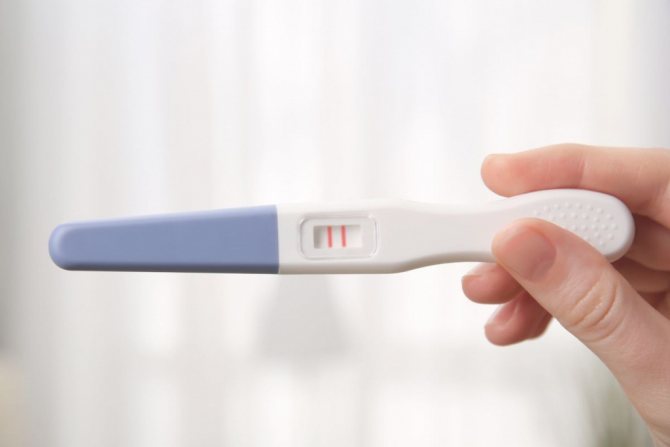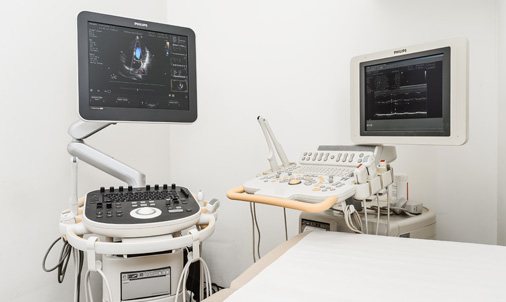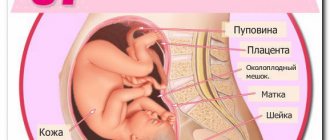07.07.2020 18177 0
To determine the gestational age, doctors usually use the obstetric calculation method. The countdown starts from the first day of the last menstruation. The embryonic period is calculated from the actual moment of conception and lags behind the obstetric period by about 14 days. The third week of pregnancy from conception corresponds to the fifth week of the obstetric period. During the first two weeks, a woman’s body prepares for conception, and if the egg has been fertilized, then the beginning of the third week is the actual conception. At this time, the fertilized egg (zygote) begins to actively divide, moving along the fallopian tubes into the uterine cavity and attaches to its wall. By the end of the third week, the development of the embryo in the womb begins.
Interesting Facts
| Options | Indications |
| Time from conception | 1 Week |
| Period by month | 3 weeks |
| What month | Goes first |
| Uterus dimensions | Normal |
| Pregnant weight | Ordinary |
Let's start with terminology. The 3rd week of pregnancy and the 3rd week from conception are completely different periods of gestation, the difference between which is 14 days. This is because in the first case, calculations are made based on the first day of the last menstruation. This is obstetric term. To find out embryonic, that is, related to conception, you need to subtract 2 weeks.
We consider the obstetric counting method to be scientifically sound and more accurate. Therefore, our calendar is compiled in accordance with it. If you want to know what happens in the 3rd week of pregnancy from conception, take a look at the 5th week page.
Basic rules for this period:
- Don't restrict yourself in food;
- Don't go on diets;
- There should be at least three meals a day (you can eat five times, but in smaller portions);
- Preference should be given to hearty food so that between meals there is no feeling of hunger.
Some foods are considered potentially dangerous, so it is better to exclude them from the earliest possible date. These include:
- Undercooked, undercooked and dried meat - it can retain viable worm larvae;
- Raw seafood. Lovers of sushi and other exotic dishes risk getting food poisoning or becoming infected with helminths;
- Fast food. This food is harmful in itself, and moreover, it is very often prepared in unsanitary conditions;
- Raw eggs. There is a risk of getting salmonellosis;
- Raw milk. From it you can become infected with brucellosis, tuberculosis, salmonellosis, leptospirosis, Staphylococcus aureus and other infections;
- Soft varieties of cheese. Sometimes they are the source of an acute infectious disease - listeriosis. If you are a big fan of this cheese, use it after heat treatment (for example, bake it in some dishes);
- Liver pates in large quantities. Frequent use of this product can lead to an excess of vitamin A in the body, which is dangerous for a pregnant woman;
- Products that contain caffeine (strong black and green tea, coffee). If you drink more than five cups of these drinks a day, you risk premature birth, miscarriage, or low birth weight of the baby. The best option is no more than three cups per day.
Well-being of the expectant mother
Significant changes are already taking place in the body, but most women are not yet aware of it. The exception is those who have a short menstrual cycle. In this case, at 3 weeks the first signs of pregnancy and unusual sensations may already appear.
Uterus and ovaries
The size of the uterus does not exceed the norm for the premenstrual period. In one of the appendages, the corpus luteum is actively working - a temporary gland formed from the ovarian follicles. It actively produces progesterone, under the influence of which the endometrium grows.
Mammary gland
The volume of the breasts has increased slightly, the nipples have become more sensitive. Some women report itching in the areola area, which can also be caused by hormonal changes in the body.
Weight gain
In the third week it is caused by fluid retention. It occurs under the influence of progesterone. The expectant mother may notice slight swelling in her clothes and shoes, which become a little tight.
Skin condition
70% of women develop rashes on their faces at this time, as in the premenstrual period. There may be some fuzz on the abdomen and chest, which will disappear after childbirth.
Timing of pregnancy determination by ultrasound.
Visualization is difficult: what does this mean?
Pregnancy and the birth of a child are the most touching, exciting, love-filled, and unforgettable stage in the life of any woman. When the expectant mother learns about the birth of a new, small life inside herself, along with a feeling of great happiness, questions arise regarding the timing of conception.
The most important question is: “At what stage can a pregnancy be detected by ultrasound?”
Because, based on this, doctors will determine the state of development of the unborn child and calculate the date of the upcoming birth.
How the fetus develops at 3 weeks of pregnancy
In obstetric practice, the third week of pregnancy is the period of ovulation and conception. The egg has already matured and is moving towards the uterus. At some point, it fuses with sperm and a zygote is formed. It's not yet a fruit. This is a cell formed from two sex gametes, which mutates and divides daily. In scientific language it is called a blastocyst, the earliest stage of embryo development.
Its size is so small that the cell can only be seen under high magnification. The yolk sac provides nutrition to the unborn baby until it attaches to the wall of the uterus.
By the end of the week, the fertilized egg will implant into the lining of the uterus and will develop and grow here. During this same period, increased production of hCG begins. Very soon, after 14-20 days, you will be able to see what the embryo looks like on an ultrasound.
Embryo 4 weeks
At week 4, the brain and spinal cord begin to form from the neural tube. At the same time, the heart makes its first contraction. Now it will not stop until the very end of life.
The rudiments of arms, legs, eyes, and internal organs are formed. Blood begins to flow in the blood vessels. Before this, the embryo received nutrients from the yolk sac, which, like in birds, contains reserves necessary for the initial stage of development. In addition, the yolk sac in mammals plays the role of the liver, bone marrow, and kidneys. It is the yolk sac that contains future germ cells, which migrate from it to the primordia of the gonads. After the appearance of the corresponding organs in the baby, it gradually disappears by the end of the first trimester.
Tests and ultrasound
In the third obstetric week, it is premature to take any tests, as they will not be informative. The only exception is home pregnancy tests: highly sensitive ones will show an accurate result even before your period is missed.
Do not rush to do an ultrasound: even with the help of modern sensitive sensors it will not be possible to see the embryo. The only indication for an ultrasound examination is alarming symptoms that suggest an ectopic pregnancy.
Possible problems
Difficulties in pregnancy occur in half of the cases in the first trimester of pregnancy. The expectant mother needs to know the warning signs in order to contact a specialist in time.
Corpus luteum deficiency
Otherwise, this is a small amount of progesterone. A woman complains of nagging pain in the lower abdomen and lower back, and slight bleeding. The problem can be successfully solved with medication if you consult a doctor in a timely manner.
Ectopic pregnancy
We can talk about it when the fertilized egg did not reach the uterus and settled in the fallopian tube or ovary. The condition is dangerous to the health and even life of a woman. Therefore, if you feel a strong pull in your stomach on the left or right, your temperature rises, you feel severe weakness and dizziness, seek help immediately. Urgent surgical intervention is required. An ultrasound and a blood test for hCG will help confirm the diagnosis.
Exacerbation of cervical pathologies
During pregnancy and hormonal imbalances, symptoms of chronic diseases may intensify. So, with erosion and ectopia, pink discharge may appear at 3 weeks of pregnancy. Endocervicitis and cysts cause profuse scarlet or brown discharge. Discuss with your doctor what treatment is possible during pregnancy and whether your diagnosis is a contraindication to natural childbirth.
What happens to the embryo
At the beginning of the third obstetric week, ovulation occurs, a mature egg leaves the ovary into the fallopian tube and lives for 24 hours. If fertilization occurs at this time, the fusion of the egg and sperm forms a new cell - a zygote.
Development.
The new cell begins to quickly divide and rise into the uterine cavity. After a few days, the zygote becomes similar to a mulberry (doctors call such a cell a morula). After a while, a multicellular embryo (blastocyst) is formed from it; it looks like a hollow ball with liquid. An embryonic disc is formed inside the ball, and the outer shell is attached to the uterus. At this stage, the embryo receives nutrients from the egg's own reserves.
After implantation into the endometrium, the embryo begins to receive nutrition from the mother. By the end of the third week, the embryonic disc curls into a tube with different diameters at the ends. On the side with a larger diameter, the formation of the head begins, and on the other, the tail-coccyx is formed.
Gender of the child.
At the time of conception, the sex of the child is determined, which depends on the sex chromosomes of the father. A female egg always contains a sex X chromosome, and male sperm carries X or Y chromosomes. If a female X chromosome merges with a male X chromosome, a girl will be born, and if with a Y chromosome, a boy will be born.

Do's and Don'ts
Lift no more than 2-3 kg: heavy loads can cause miscarriage. Do not deny yourself entertainment, travel and long walks: pleasant experiences always have a positive effect on your health. Even if pregnancy occurs, this is not a reason to refuse intimate life. In the absence of complications, physical intimacy will be beneficial, because it stimulates blood circulation in the pelvis and produces the hormone of happiness.
Now you can afford small doses of alcohol. No, we do not recommend indulging in heavy libations. But if in the third week of pregnancy you drank a couple of glasses of wine, nothing bad happened: the embryo is not yet connected to the mother’s general bloodstream, so it will not be harmed.
How is the research done and when is it carried out?

A planned anatomical ultrasound examination is prescribed for the period 14–16 weeks of pregnancy. But if in a woman who has previously given birth, with a previous pregnancy, the labor process began earlier than the appointed time, an ultrasound of the cervix is prescribed approximately at the end of the 12th week. After which, observations are repeated at intervals of two weeks.
The following indicators are considered additional reasons for ultrasound of the cervix:
- Miscarriage that occurred in the first pregnancy at a late stage;
- Conception with the presence of two or more fetuses;
- Various reasons for terminating a previous pregnancy;
- Suspicions of isthmic-cervical insufficiency;
Any previous surgical interventions in the field of gynecology.
Ultrasound of the cervix, as well as diagnostics to detect pregnancy, is done in two ways, abdominal and vaginal. In the first case, the uterus is visible through the anterior wall of the abdominal cavity. The doctor makes a conclusion about the position, condition, parameters of the uterus, and also gives a description of the external pharynx.
Vaginal ultrasound examination is performed by inserting a special sensor into the vagina. This case is more effective than the previous one, since it becomes possible to measure the length of the cervix, the size of the internal pharynx and the cervical canal.
As a rule, special preparation for an ultrasound is not required; only in the early stages of pregnancy, the doctor may ask you to pre-fill the bladder.
Diagnosis through vaginal and abdominal examination is considered absolutely safe for pregnant women. Visualization is difficult: meaning
When during an ultrasound, your doctor, based on the examination results, says that visualization is difficult, this is not a reason to panic. For personal peace of mind, you should understand what this means.
If the pregnancy proceeds without any problems, a routine ultrasound examination is performed during the 24th week. An ultrasound of the pelvic organs in the first trimester will not provide as much important information as in the second trimester.
Therefore, during this period, future parents will hear the long-awaited and joyful news about the gender of their baby, as well as whether there are any abnormalities or pathologies in the development of the fetus.
The size of the unborn baby in the second trimester is quite large, which allows the doctor to clearly examine all its organs. In addition to growth and assessment of the child’s condition, at 24 weeks, the doctor will examine the placenta, which by this time has become denser in structure than in the first trimester, and will also diagnose the amount of amniotic fluid.
Visualization is difficult during pregnancy; in simple words, this is when the fetus is located in such a way that none of the above is simply visible to the doctor. Of course, this does not mean that you should be upset or consider it a violation in the child’s development, because there will be another third planned ultrasound examination ahead, at 34 weeks.
Checklist 3 weeks pregnant
- Continue to take folic acid: it will prevent the development of neural tube defects in the fetus.
- Include more fresh vegetables and fruits, berries and herbs in your daily diet. A balanced diet for the expectant mother is important for the healthy development of the child.
- Stop smoking, including passive smoking. It has also been proven that it negatively affects the health of the mother and fetus.
- Choose pregnancy tests with high sensitivity: these are numbers 10 or 15 on the package. They can show reliable results even before a missed period.
- Be mindful of your body. If you experience nagging pain or bleeding, do not put off visiting a gynecologist.
Specialists from the Women's Medical Center will help you choose an effective individual pregnancy management program. We adhere to a strict scientific approach and have many years of successful experience in the prevention and treatment of various complications of gestation.
To drink or not to drink
Alcohol
. The inability of a woman with alcohol addiction to stop drinking alcohol while pregnant increases the risk of having a baby with a serious pathology (including FAS - fetal alcohol syndrome). But if you, unaware of your developing pregnancy, allowed yourself a glass or two of wine, thoughts about possible negative consequences will cause you more harm than the fact of drinking alcohol. Now you are aware of your new situation and will be more attentive to your lifestyle.
Tea and coffee
. If you're feeling weak and looking to boost your activity with these drinks, remember: coffee may work faster but have a short-term effect, while tea has a gradual and longer-lasting effect. Tea contains more caffeine, but it is believed that, unlike coffee, it does not have side effects on the central nervous system.
Of the types of tea, give preference to green. Be careful with herbal supplements, as some may adversely affect pregnancy and fetal development. Arabica coffee is the most harmless variety: Robusta has almost twice as much caffeine. Watch the strength: the more coffee used to prepare one cup of drink, the stronger its effect on our body. There is very little caffeine in decaf, a decaffeinated drink.
You can consider chicory
. It is recommended for certain diseases: gastritis, pancreatitis, type 2 diabetes, gout, etc. It perfectly invigorates and tones. However, no matter what beneficial properties a particular drink has, its taste plays an important role, especially in cases of toxicosis. So the choice is yours.











